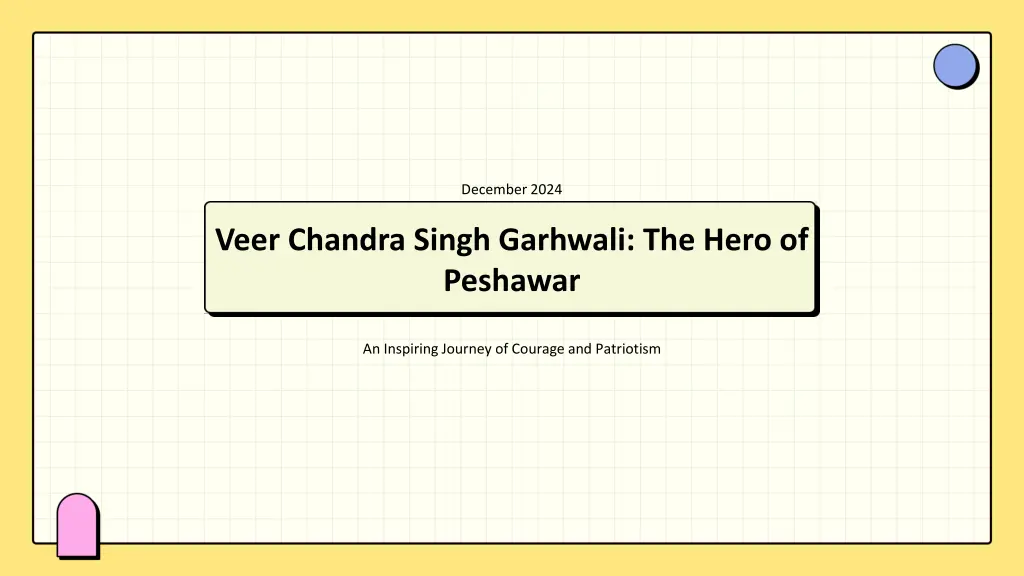
Veer Chandra Singh Garhwali: The Hero of Peshawar - A Story of Courage and Patriotism
Explore the inspiring journey of Veer Chandra Singh Garhwali, a brave soldier who defied orders during the Peshawar incident, becoming a symbol of non-violent resistance and inspiring future freedom fighters. His legacy continues to influence generations, celebrated through literature, memorials, and events.
Download Presentation

Please find below an Image/Link to download the presentation.
The content on the website is provided AS IS for your information and personal use only. It may not be sold, licensed, or shared on other websites without obtaining consent from the author. If you encounter any issues during the download, it is possible that the publisher has removed the file from their server.
You are allowed to download the files provided on this website for personal or commercial use, subject to the condition that they are used lawfully. All files are the property of their respective owners.
The content on the website is provided AS IS for your information and personal use only. It may not be sold, licensed, or shared on other websites without obtaining consent from the author.
E N D
Presentation Transcript
December 2024 Veer Chandra Singh Garhwali: The Hero of Peshawar An Inspiring Journey of Courage and Patriotism
Table of Contents Introduction to Veer Chandra Singh Singh Garhwali 5 Legacy and Influence 1 6 Recognition and Honors 2 Early Life and Background Military Career 7 Cultural Impact 3 Peshawar Incident 8 Lessons from His Life 4
9 Conclusion 10 Further Reading and Resources
Introduction to Veer Chandra Singh Garhwali 1. Born on December 25, 1891, in Garhwal, India, Chandra Singh Garhwali was destined for greatness. 2. Joined the British Indian Army and rose to the rank of Havildar Major. 3. Remembered as the hero of the Peshawar incident on April 23, 1930. 4. His actions inspired future generations of freedom fighters. 5. Honored for his bravery and commitment to the nation.
Early Life and Background 1. Raised in a humble family with strong values. 2. Received basic education in his village. 3. Inspired by the freedom movement and leaders of his time. 4. Enlisted in the British Indian Army to serve the nation. 5. Deeply rooted in Garhwali culture and traditions.
Military Career 1. Joined the army at a young age, driven by patriotism. 2. Served bravely during World War I, gaining recognition. 3. Promoted due to his leadership and dedication. 4. Led a non-violent protest against orders to fire on unarmed civilians. 5. Faced court martial for defying orders, becoming a symbol of resistance.
Peshawar Incident 1. Occurred on April 23, 1930, during the freedom struggle. 2. Ordered to fire on unarmed protesters, he refused. 3. His refusal marked a significant act of non-violent resistance. 4. Inspired many to join the struggle for independence. 5. A turning point in India's fight for freedom.
Legacy and Influence 1. Became a role model for soldiers and civilians alike. 2. Inspired leaders like Mahatma Gandhi and Jawaharlal Nehru. 3. Celebrated in literature, songs, and folklore. 4. Honored through various memorials and events. 5. His story continues to inspire new generations.
Recognition and Honors 1. Recognized by the Indian government for his bravery. 2. Received numerous awards for his service and courage. 3. Commemorated in public events and ceremonies. 4. Subject of books and articles celebrating his life. 5. Acknowledged internationally for his contributions.
Cultural Impact 1. Immortalized in songs and ballads across India. 2. Stories of his bravery are told in folk tales. 3. His life depicted in plays and dramas. 4. Inspired artists to create works in his honor. 5. Celebrated in cultural festivals and events.
Lessons from His Life 1. Taught the importance of courage and integrity. 2. Emphasized the power of non-violent resistance. 3. Exemplified true leadership in challenging times. 4. Instilled a deep sense of patriotism and duty. 5. Showed resilience in the face of adversity.
Conclusion 1. Recap of his significant contributions to India's freedom. 2. His influence continues to be felt today. 3. Remembered as a hero who stood for justice and peace. 4. Continues to inspire future generations to stand for what is right. 5. Encourages us to embody his values in our own lives.
Further Reading and Resources 1. Recommended books for further reading. 2. Watch documentaries and films about his life. 3. Read articles and essays online. 4. Visit museums and exhibitions dedicated to his memory. 5. Join discussions and forums to learn more.
